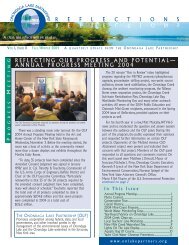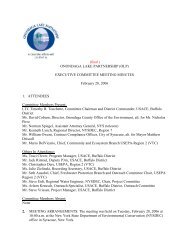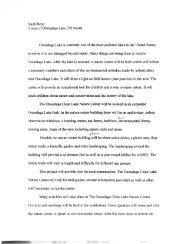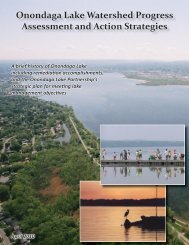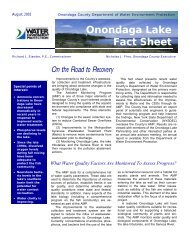Newsletter '06 - Onondaga Lake Partnership
Newsletter '06 - Onondaga Lake Partnership
Newsletter '06 - Onondaga Lake Partnership
Create successful ePaper yourself
Turn your PDF publications into a flip-book with our unique Google optimized e-Paper software.
JOIN US FOR A DAY OF FAMILY FUN AT ONONDAGA LAKE DAY, JUNE 3. SEE PAGE 4<br />
A clean lake reflects well on all of us.<br />
SPECIAL ONONDAGA LAKE PARTNERSHIP EDITION MAY 2006<br />
I T ’ S M O R E T H A N J U S T A L A K E<br />
• <strong>Onondaga</strong> <strong>Lake</strong> is 4.6<br />
miles long and 1 mile<br />
wide and covers 4.6<br />
square miles.<br />
• About 265,000 people<br />
live in the <strong>Onondaga</strong><br />
<strong>Lake</strong> watershed<br />
according to the 2000<br />
census.<br />
• <strong>Onondaga</strong> <strong>Lake</strong>’s<br />
average depth is 35<br />
feet. The deepest<br />
point is 63 feet.<br />
This insert is intended to provide general information to the public regarding the <strong>Onondaga</strong> <strong>Lake</strong> basin and activities related to the cleanup and restoration thereof.<br />
Approval for publication by the members of the OLP does not signify adoption or approval for purposes of regulatory, enforcement or other legal actions, of the<br />
factual, scientific, or legal assertions, characterizations or conclusions contained therein.
THE SPRINGS OF ONONDAGA<br />
H Y D R O G E O L O G Y 1 0 1 — T H E S P R I N G S O F O N O N D A G A<br />
“spring—A place where, without the agency<br />
of man, water flows from rock or soil upon<br />
the land.”<br />
Dorwin Spring—This spring is found along the<br />
west wall of the <strong>Onondaga</strong> Valley, along New<br />
York State Route 80. The large stone 'box' and<br />
pipe discharging from it used to supply drinking<br />
water to local residents living in the south end of<br />
the City of Syracuse.<br />
Gale Spring—The Gale Spring is found along the<br />
<strong>Onondaga</strong> <strong>Lake</strong> Parkway. The stone-lined pool and<br />
structure was built during the 1930's to mark the<br />
location of a brine spring that was used to make<br />
salt in that area. The discharge of water today is<br />
only saline (less than seawater quality), and the<br />
iron color in the water is due to iron bacteria that<br />
thrive on the high iron content discharged from<br />
the spring.<br />
Springs in the <strong>Onondaga</strong> <strong>Lake</strong> watershed have many different sources<br />
and vary in their water quality. Most springs in the Syracuse area<br />
discharge water at a temperature of about 50-52 degrees Fahrenheit, or<br />
about 10-11 degrees Celsius. This temperature is the average annual air<br />
temperature for our area. The water discharged from them can tell us<br />
much about the geology of the watershed as well as how ‘clean’ the<br />
ground water system is.<br />
Beginning in the southern end of the <strong>Onondaga</strong> <strong>Lake</strong> watershed, the<br />
first location for spring discharges is the Tully Moraine—here a veneer<br />
of sand and gravel overlies fine-grained clay and silt deposits. The springs<br />
at the Moraine discharge into the Tully Valley from sand and gravel and<br />
provide both drinking water for local residents and cold-water habitat<br />
for native Brook Trout populations in the headwaters of <strong>Onondaga</strong><br />
Creek.<br />
North of the moraine, a series of naturally fresh to brackish (slightly<br />
salty) springs exist on the floor of the Tully Valley, within several landslide<br />
areas at the foot of Bare Mountain, and flows from the valley walls of<br />
both the Tully and West Branch valleys. The mudboils on the Tully Valley<br />
floor and some of the landslide springs are driven by artesian pressure.<br />
The mudboils discharge not only water but fine-grained sediment to<br />
<strong>Onondaga</strong> Creek creating turbid (muddy looking) conditions in the<br />
creek. Some of the mudboils discharge fresh water while others are<br />
brackish, indicating variable quality of the unconsolidated (soil) aquifers<br />
within the valley. The landslide areas discharge generally brackish water<br />
from the deeper shale bedrock.<br />
Elsewhere, freshwater springs discharge from the base of the valley<br />
wall from large sand and gravel deposits or from the shale bedrock higher<br />
on the valley wall. These springs continue to be utilized as water supplies<br />
for individual residents as well as small communities—such as Cardiff and<br />
the <strong>Onondaga</strong> Nation.<br />
Further to the north toward the southern end of Syracuse, the valley<br />
walls are comprised of limestone bedrock where water can easily flow<br />
through bedrock fractures and appear as springs along the base of the<br />
valley walls. Dorwin Spring on the west side of the <strong>Onondaga</strong> Valley and<br />
Cold Spring on the east side were originally water sources for people<br />
who lived in this part of Syracuse. A large number of springs lie on both<br />
sides of the valley between (roughly) Dorwin and Brighton Avenues,<br />
many of which presently drain to <strong>Onondaga</strong> Creek through the<br />
stormwater sewer system. The Furnace Brook watershed (Elmwood Park)<br />
is almost entirely spring-fed, while the Grottos found along Grand<br />
Avenue (in the Harbor Brook watershed) are also bedrock-fed springs.<br />
In the Nine Mile Creek watershed to the west, the same limestone<br />
bedrock units that appear in the <strong>Onondaga</strong> valley are also found near<br />
the village of Marcellus. There are a number of springs that discharge to<br />
Nine Mile Creek, from Marcellus down to Camillus, which provide<br />
excellent trout habitat. Some of the Marcellus-area springs may be<br />
sourced from “Disappearing <strong>Lake</strong>,” an unusual lake that usually “appears” in<br />
the fall, persists through the winter, and slowly “disappears” the following<br />
summer. This “lake” sits on the <strong>Onondaga</strong> limestone where surface water<br />
discharges from the lake through fractures in the limestone. Similar<br />
features are also found near Camillus where ground water in the limestone<br />
bedrock discharges back to surface water streams.<br />
Old maps of downtown Syracuse indicate a number of freshwater<br />
springs discharged from several sources along James Street. These probable<br />
bedrock springs were routed downtown via pipelines to a fountain that<br />
served downtown residents. These springs are long lost to the development<br />
that took place in this part of the city.<br />
The most famous springs of Syracuse are the brine springs that gave<br />
the city its nickname, “The Salt City.” These very salty springs were located<br />
around the southeastern end of <strong>Onondaga</strong> <strong>Lake</strong> near the old lakeshore<br />
(prior to 1822). The largest number of ‘salt’ springs were located under<br />
what is now the Carousel Mall area. Today, due to land-filling and<br />
construction, these springs are no longer present, although one large<br />
spring discharges to <strong>Onondaga</strong> Creek between Spencer and Kirkpatrick<br />
Streets.<br />
Finally, there are a number of springs that lie around <strong>Onondaga</strong> <strong>Lake</strong><br />
and feed the smaller tributaries that drain to the lake and the Seneca<br />
River. The best-known spring lies in the hamlet of Cold Springs along the<br />
Seneca River. This spring discharges from a wetland area near Route 370<br />
and Klein Island. Other springs also exist along the Seneca River which<br />
discharge from the bedrock and shallow unconsolidated sediments.<br />
Many of these springs, be they salty or fresh, were important to the<br />
development of the greater Syracuse region. Today, with public water<br />
supplies piped from Skaneateles and Otisco <strong>Lake</strong>s, as well as <strong>Lake</strong> Ontario,<br />
the Springs of <strong>Onondaga</strong> <strong>Lake</strong> are little utilized, but are important<br />
indicators of the water quality of the <strong>Onondaga</strong> watershed. Their<br />
continued use as water supplies for some residents, and as a key factor in<br />
preserving trout habitat in both <strong>Onondaga</strong> and Nine Mile creeks, makes<br />
the preservation of these springs and their contributing areas that much<br />
more important to each of us. ■<br />
One of the Grotto Springs discharging fresh<br />
water from bedrock near the Burnet Park Zoo (A<br />
former drinking-water supply, not presently used<br />
due to bacterial contamination)<br />
Salt spring at landslide. Discharge from one of the<br />
springs inside the 1993 slide area. This spring is the<br />
saltiest (about as salty as seawater), with a large<br />
amount of sulfur bacteria (white material) in the<br />
discharge from the spring.<br />
POPULAR TULLY VALLEY MUDBOIL<br />
TOUR OFFERED<br />
AGAIN THIS YEAR<br />
Bill Kappel, geologist with the US<br />
Geological Survey, aka “The Tully Mudmeister,”<br />
is again offering his popular and educational<br />
tour of the Tully Valley mudboils on<br />
<strong>Onondaga</strong> <strong>Lake</strong> Day, Saturday, June 3. This<br />
year’s field trip will include a valley overlook,<br />
the 1993 mudslide and mudboil areas, and if<br />
time allows, the Tully moraine and lakes area.<br />
One tour will be offered at 9 AM. Reservations<br />
Mudboil downcut<br />
are required.<br />
Only a limited number of persons can be included in this trip, and<br />
carpooling is encouraged. Tour participants should wear appropriate field clothing<br />
and will be required to sign a release form. The trip is not appropriate for small<br />
children. Please call Bill Kappel at (607) 266-0217, ext. 3013, to make reservations.<br />
Leave your name, phone number, and number of participants. If you leave a<br />
message and don’t speak directly with Bill, you will receive a confirmation call<br />
verifying your tour reservation. Tour participants should meet in the parking lot<br />
behind McDonald’s at the Lafayette exit off Route I-81 south of Syracuse and<br />
will carpool from there. New this year at <strong>Onondaga</strong> <strong>Lake</strong> Day, Bill will also be<br />
giving a presentation on "Everything you wanted to know about salt, mud and<br />
the geology of the lake" at 1 pm at <strong>Onondaga</strong> <strong>Lake</strong> Park. Come ask your questions. ■<br />
2
B E S T Y E A R S S T A R T N O W F O R<br />
O N O N D A G A L A K E<br />
The best years for <strong>Onondaga</strong> <strong>Lake</strong> lie ahead, and those years are beginning<br />
now. Everyone can contribute to the revitalization of <strong>Onondaga</strong> <strong>Lake</strong> by<br />
learning more about the <strong>Lake</strong>, participating in <strong>Onondaga</strong> <strong>Lake</strong> <strong>Partnership</strong><br />
(OLP) activities and practicing sound environmental measures in their<br />
homes and businesses in the lake’s watershed. A clean lake reflects well on<br />
all of us.<br />
The OLP, with nearly 40 members from government agencies as well as<br />
representatives from the private sector, education, and non-profit<br />
organizations, takes a comprehensive, holistic approach to the cleanup and<br />
rehabilitation of <strong>Onondaga</strong> <strong>Lake</strong> and its watershed—one that addresses air,<br />
water and land issues. To date approximately $146 million in federal funding<br />
secured by Congressman James T. Walsh, along with approximately $95<br />
million from New York State, and local funding provided mostly by<br />
<strong>Onondaga</strong> County has been allocated to various projects to promote<br />
improvement in the long-term health of <strong>Onondaga</strong> <strong>Lake</strong>.<br />
The <strong>Partnership</strong>’s three committees—Executive, Project, and Outreach—<br />
maintain its mission and its lake improvement efforts, uphold technical<br />
standards in the projects it oversees, and enhance public knowledge and<br />
understanding of its activities.<br />
<strong>Onondaga</strong> <strong>Lake</strong> has been profoundly affected by a long history of abuse.<br />
Under the guidance of the OLP, a comprehensive cleanup and revitalization<br />
program is underway. The <strong>Onondaga</strong> <strong>Lake</strong> Management Plan—along with<br />
the Amended Consent Judgment, a court-mandated agreement—guides<br />
efforts to revitalize, conserve, and manage the lake and watershed. Many<br />
projects have been completed and more are underway. <strong>Onondaga</strong> <strong>Lake</strong><br />
revitalization projects are achieving significant results. Water quality has<br />
improved substantially since revitalization efforts began. Currently, ammonia<br />
levels in the lake water have been reduced to a level that consistently<br />
complies with and exceeds New York State water quality standards;<br />
phosphorus levels have also been reduced. Today populations and varieties<br />
of fish in <strong>Onondaga</strong> <strong>Lake</strong> are on the rise and reflect a vast improvement<br />
from earlier conditions. Recent sampling efforts have identified over 50 fish<br />
species in <strong>Onondaga</strong> <strong>Lake</strong>.<br />
More ammonia and phosphorus is removed from wastewater before it is discharged to <strong>Onondaga</strong> <strong>Lake</strong> as a result of upgrades<br />
to the Metropolitan Syracuse Wastewater Treatment Plant<br />
To emphasize the importance of <strong>Onondaga</strong> <strong>Lake</strong> to the community, OLP<br />
is accepting applications from teachers for small grants for projects up to<br />
$500 for classroom and field projects to educate students about the<br />
environment of <strong>Onondaga</strong> <strong>Lake</strong>, its tributaries, and watershed. Applicants<br />
must be teachers in a public or private school within or contiguous with<br />
the <strong>Onondaga</strong> <strong>Lake</strong> Watershed. Applications are available on the OLP<br />
website at www.onlakepartners.org or by calling the <strong>Onondaga</strong><br />
Environmental Institute at (315) 472-2150 ext. 24. Applications are being<br />
accepted now for both the 2005-2006 and the 2006-2007 school years.<br />
All applications meeting eligibility requirements will be approved until<br />
funding runs out.<br />
We invite you to browse our website for additional information at<br />
www.onlakepartners.org. Please subscribe to our electronic mailing list to<br />
receive invitations to events such as <strong>Onondaga</strong> <strong>Lake</strong> Day, scheduled for<br />
June 3, 2006, and our annual public meeting, and to receive quarterly<br />
newsletters and information on our mini grant and education fund<br />
programs. For questions about the <strong>Onondaga</strong> <strong>Lake</strong> <strong>Partnership</strong>, you can<br />
also call us at 800-833-6390. ■<br />
D U N B A R ’ S T R U T H A B O U T<br />
O N O N D A G A C R E E K<br />
Dunbar kids at <strong>Onondaga</strong> Creek<br />
As part of the <strong>Onondaga</strong> Creek Revitalization Project, a group of kids<br />
from the Dunbar Center had the opportunity to explore different sections<br />
of <strong>Onondaga</strong> Creek with educators from Cornell University Cooperative<br />
Extension. At each site, the kids recorded their impressions as well as<br />
what they liked, what they didn’t like and what they would change if they<br />
were in charge. Below is a sampling of their thoughts as expressed the<br />
day of the trip and as part of a huge poster they created and named<br />
“Dunbar’s Truth About <strong>Onondaga</strong> Creek.”<br />
What they said they would tell their friends about the creek<br />
“It’s very peaceful and quiet. Somewhere where you might want to do<br />
your homework.”<br />
“I would tell my friends that this place is calm and fresh.”<br />
What they liked<br />
“It was good cause you get to see the fish jump.”<br />
“I like the fact that we could just stand there and enjoy the view of<br />
the water.”<br />
What they did not like<br />
“I don’t like the dirtiness of the water.”<br />
“I don’t like the algae.”<br />
What they would change if they were in charge<br />
“If I was in charge of <strong>Onondaga</strong> Creek, I would make it have a running/walking/biking<br />
area, an area for homework, an area to enjoy yourself,<br />
and a recreational area (fishing, bird watching, etc).”<br />
“If I was in charge of <strong>Onondaga</strong> Creek, I would clean it up then open<br />
it up for fishing.” ■<br />
FIND OUT ABOUT OLP EDUCATION<br />
FUND OPPORTUNITIES.<br />
VISIT WWW.ONLAKEPARTNERS.ORG.<br />
D U N B A R ’ S T R U T H A B O U T O N O N D A G A C R E E K<br />
3
ONONDAGA LAKE DAY FILLED WITH FUN ACTIVITIES<br />
The fifth annual <strong>Onondaga</strong> <strong>Lake</strong> Day takes place on Saturday, June 3 from<br />
10am to 3pm at <strong>Onondaga</strong> <strong>Lake</strong> Park, behind the Griffin Visitor’s Center near<br />
the lake’s shore. All activities are free and open to the public. The event is sponsored<br />
by the <strong>Onondaga</strong> <strong>Lake</strong> <strong>Partnership</strong> (OLP) and is designed to bring people<br />
to the lake to take part in a variety of fun and educational activities. “Each year,<br />
we have people comment that they’ve learned something new and had a great<br />
time,” Sue Miller, event chair for the OLP’s Outreach Committee, reports.<br />
According to Miller, this year’s event “will showcase the improvements brought<br />
about in the lake through OLP programs and promote steps that individuals can<br />
take to help the lake as well.”<br />
The following will be offered throughout the day from 10am to 3pm:<br />
• Exhibits and displays by OLP members and other organizations related to te<br />
uses and ecology of the <strong>Lake</strong>, its shoreline and its watershed, and projects<br />
underway to improve the lake.<br />
• The amazing Dr. WOW will perform exciting science demonstrations about<br />
water for kids of all ages.<br />
• Narrated Tram Tours will run throughout the day leaving from the Visitor’s<br />
Center with stops related to the history and ecology of the lake.<br />
• Boat Tours are back, leaving from the pier behind the Salt Museum. Enjoy a<br />
water side view of the lake.<br />
• Ultimate Sports with a lake view will offer kids and adults alike an opportunity<br />
to join in some traditional sports with new twists, on the lawn behind the<br />
Visitor’s Center.<br />
• Live fish from the lake will be displayed in a tank staffed by <strong>Onondaga</strong><br />
County’s Department of Water Environment Protection lake monitoring<br />
personnel. See how many fish you can identify.<br />
• Test your knowledge of the <strong>Lake</strong>–take the <strong>Lake</strong> WQ/IQ Test.<br />
• Take a spin on a bicycle built for three or more. Rides start at the Information<br />
Tent.<br />
• Attend an Open House at the <strong>Onondaga</strong> Yacht Club.<br />
• Visit the Salt Museum and learn about the area’s salty past.<br />
• Get your kids’ photo taken with Ronny Raindrop.<br />
New this year will be a number of special presentations throughout the day<br />
including the following:<br />
• Learn to Fish Clinic (10am–2pm) for youngsters 15 years and younger<br />
sponsored by the Izaak Walton League and the Fisheries subcommittee. Casting,<br />
and catch and release techniques will be taught. Fishing gear will be available for<br />
youngsters to try to catch fish in the <strong>Lake</strong>.<br />
• Plant a tree demonstration and information. Free trees will be handed out by<br />
the New York State Department of Environmental Conservation after the tree<br />
demonstration event.<br />
• Come “Ask the Expert” at 1pm. Ever wonder why the lake isn’t salty, how the<br />
lake was formed and what the Tully mudboils have to do with <strong>Onondaga</strong> <strong>Lake</strong>?<br />
Come talk to Dr. Mud and get the answers (Information Tent).<br />
• Zoo to You–staff of the Friends of the Rosamond Gifford Zoo will bring<br />
critters who reside around the lake and share interesting information about<br />
their habitat–see the elusive spotted salamander and box turtle up close.<br />
• Learn how to make bluebird houses and see the new wood duck houses that<br />
will be installed around the lake to encourage nesting.<br />
• Watch an Introduction to Sailing by the Yacht Club for all ages.<br />
<strong>Lake</strong> Day participants can take away plenty of information as well as posters<br />
for school classrooms, coloring books, collector cards, litter bags, rain gauges<br />
and other interesting, informative and free materials.<br />
For a complete listing of the day’s schedule of activities and presentations,<br />
visit www.onlakepartners.org.<br />
OTHER EVENTS<br />
Enjoy what <strong>Onondaga</strong> <strong>Lake</strong> and its watershed have to offer. The <strong>Onondaga</strong><br />
<strong>Lake</strong> <strong>Partnership</strong> (OLP) hopes to see you at these upcoming events:<br />
• <strong>Onondaga</strong> <strong>Lake</strong> Day, Saturday, June 3<br />
Contact: OLP (800) 833-6390<br />
• Carp Fishing Clinics, Saturday, June 10 & 17<br />
Contact: Al Daher (315) 458-7998<br />
• Carp Fishing Tournament, Saturday, June 24<br />
Contact: Al Daher (315) 458-7998<br />
• Family Fishing Derby, Sunday, June 25<br />
Contact: Al Daher (315) 458-7998<br />
• Water Chestnut Hand Pulling, Saturday, July 15<br />
Contact: Cornell Cooperative Extension (315) 424-9485<br />
• <strong>Onondaga</strong> Creek Cleanup, Saturday, September 9 & 16<br />
Contact: Cornell Cooperative Extension (315) 424-9485<br />
• World Water Monitoring Day, Wednesday, October 4<br />
Contact: Hillary Wolfe (315) 472-2150<br />
• Annual Progress Meeting, Wednesday, October 25<br />
Contact: OLP (800) 833-6390<br />
Call the contacts listed above or visit www.onlakepartners.org to learn<br />
more about <strong>Onondaga</strong> <strong>Lake</strong> and how you can get involved!<br />
THIS INSERT IS PUBLISHED BY THE ONONDAGA LAKE<br />
PARTNERSHIP WITH FUNDING PROVIDED BY THE U.S.<br />
ENVIRONMENTAL PROTECTION AGENCY.<br />
EXECUTIVE COMMITTEE MEMBERS<br />
Chaired by U.S. Army Corps of Engineers<br />
• U.S. Army Corps of Engineers<br />
• U.S. Environmental Protection Agency<br />
• New York State Department of Environmental Conservation<br />
• New York State Attorney General<br />
• <strong>Onondaga</strong> County<br />
• City of Syracuse<br />
PROJECT COMMITTEE MEMBERS<br />
Chaired by New York State Department of Environmental Conservation<br />
Representatives of Executive Committee agencies, as well as:<br />
• Department of Public Works<br />
• U.S. Geological Survey<br />
• <strong>Onondaga</strong> County Soil and Water Conservation District<br />
• Department of Housing and Urban Development<br />
• Central New York Regional Planning and Development Board<br />
• Metropolitan Development Association<br />
OUTREACH COMMITTEE MEMBERS<br />
Chaired by U.S. Environmental Protection Agency<br />
Representatives of Executive Committee agencies, as well as:<br />
• Izaak Walton League<br />
• Atlantic States Legal Foundation<br />
• League of Women Voters<br />
• Cornell University Cooperative Extension, <strong>Onondaga</strong> County<br />
• State University of New York — College of Environmental Science<br />
& Forestry<br />
• <strong>Onondaga</strong> Historical Association<br />
The Executive Committee establishes and maintains the mission<br />
of the partnership and the lake improvement effort.<br />
The Project Committee serves as the partnership technical center<br />
of expertise on specific projects and develops and maintains the<br />
funding strategy for projects.<br />
The Outreach Committee works to enhance public knowledge<br />
and understanding of the partnership and the status of the lake<br />
improvement effort.<br />
YOU CAN CONTACT THE ONONDAGA LAKE PARTNERSHIP AT:<br />
(800) 833-6390<br />
info@onlakepartners.org<br />
FOR MORE INFORMATION, VISIT THE ONONDAGA LAKE<br />
PARTNERSHIP WEB SITE AT WWW.ONLAKEPARTNERS.ORG<br />
FUN FACTS<br />
• The major natural tributaries of <strong>Onondaga</strong> <strong>Lake</strong> are <strong>Onondaga</strong><br />
Creek through the City of Syracuse and Nine Mile Creek in<br />
the towns of Geddes, Camillus and Marcellus.<br />
• Anyone can participate in the revitalization of <strong>Onondaga</strong> <strong>Lake</strong><br />
by practicing sound environmental measures at home and at<br />
work in <strong>Onondaga</strong> <strong>Lake</strong>’s watershed.<br />
Learn more about your part in <strong>Onondaga</strong> <strong>Lake</strong>’s future by<br />
visiting www.onlakepartners.org<br />
THE ONONDAGA LAKE PARTNERSHIP (OLP)<br />
Promotes cooperation among federal, state, and local<br />
governments, and other involved parties in the management<br />
of the environmental issues of <strong>Onondaga</strong> <strong>Lake</strong> and the<br />
<strong>Onondaga</strong> <strong>Lake</strong> watershed in the Syracuse, New York area.<br />
V i s i t o u r w e b s i t e a t :<br />
w w w . o n l a k e p a r t n e r s . o r g<br />
This insert uses recycled paper content and soy inks.<br />
C O M M I T T E E I N F O R M A T I O N<br />
4




